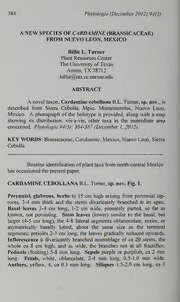
A new species of Cardamine (Brassicaceae) from Nuevo Leon, Mexico PDF
Preview A new species of Cardamine (Brassicaceae) from Nuevo Leon, Mexico
384 Phytologia (December2012) 94(3) A NEW SPECIES OF C4/?Z)/4M/7VE(BRASSICACEAE) FROM NUEVO LEON, MEXICO Biilie L. Turner Plant Resources Center The University ofTexas Austin, TX 78712 [email protected] ABSTRACT A novel taxon, Cardamine cebollana B.L. Turner, sp. nov., is described from Sierra Cebolla, Mpio. Montemorelos, Nuevo Leon, Mexico. A photograph ofthe holotype is provided, along with a map showing its distribution, vis-a-vis, other taxa in the immediate area concerned. Phytologia 94(3): 384-387 (December 1, 2012). KEY WORDS: Brassicaceae, Cardamine, Mexico, Nuevo Leon, Sierra Cebolla Routine identification ofplanttaxa fi'om north-central Mexico has occasioned the present paper. CARDAMINE CEBOLLANA B.L. Turner, sp. nov. Fig. 1. Perennial, glabrous, herbs to 15 cm high arising from perennial tap- mm roots, 3-4 thick and the stems divaricately branched at its apex. Basal leaves 3-4 cm long, 1-2 cm wide, pinnately parted, so far as known, not persisting. Stem leaves (lower) similar to the basal, but larger (4-5 cm long), the 4-8 lateral segments oblanceolate, entire, or asymetrically basally lobed, about the same size as the terminal segments; petioles 2-3 cm long, the leaves gradually reduced upwards. Inflorescence a divaricately branched assemblage of ca 20 stems, the whole ca 8 cm high, and as wide, the branches not at all fractiflex. mm mm Pedicels (fi-uiting) 5-8 long. Sepals purple or purplish, ca 2 mm mm long. Petals, white, oblancelate, 2-4 long, 0.5-1.0 wide. Anthers, yellow, 4, ca 0.3 mm long. Siliques 1.5-2.0 cm long, ca 1 Phytologia (December2012) 94(3) 385 mm mm mm wide, erect, glabrous. Seeds ovoid, ca 1 long, 0.8 wide, glabrous, minutely rugose, 18-20 per fruiting body. TYPE: MEXICO. NUEVO LEON: Mpio. Montemorelos, "6 Km SE ofLaTrinidad, in La SierraCebolla,justbelow the summit ofone [sic] the picachos, on limestone, in fir-oak-Cupressus woodland." 2900 m, 25 1 1 N, 100 07 W, 5 Aug 1988, T. F. Patterson (5750(Holotype: TEX). In the treatment ofCardamine for Mexico and Central America by Rollins (1993), largely because of its perennial habit and reddish & sepals, C. cebollana will key to or near C. eremita Standi. Steyerm., a localized, alpine, endemic ofGuatemala. Amongst Mexican taxa of Cardamine, the novelty appears to have no close relatives, although it resembles, vegetatively, C. macrocarpa Brandegee, but lacks the fractiflex racemes and large siliques ofthat species. The novelty is named for the Sierra La Cebolla, to which it seems confined; the latter locale and immediate environs is home to a number of localized endemics, including Pinarpappuspattersonii B.L. Turner andSeneciopattersonii B.L. Turner (Turner 1988; Turner 1996) and, more importantly, the very localized, Picea martinezii T.F. Patterson (Patterson 1988). ACKNOWLEDGEMENTS 1 am grateful to my field companion, Jana Kos, for proof- reading the paper, and to my Academic son, Tom Patterson, for helpful comments. LITERATURE CITED Patterson, T.E. 1988. A new species ofPicea (Pinaceae) from Nuevo Leon, Mexico. Sida 13: 131-135. Rollins, R.C. 1993. The Cruciferae ofContinental North America. Stanford Univ. Press, Stanford. Turner, B.L. 1988. A new species ofSenecio (Asteraceae) from Nuevo Leon, Mexico. Phytologia65: 373-374. Turner, B.L. 1996. Two new cliff-dwelling species ofPinaropappus (Asteraceae, Lactuceae) fi'om Coahuila, Mexico. Phytologia 80: 100-103. 386 Phytologia (December2012) 94(3) Fig. 1. Photograph ofCardamine cebollana (Holotype: TEX). Phytologia (December2012) 94(3)
